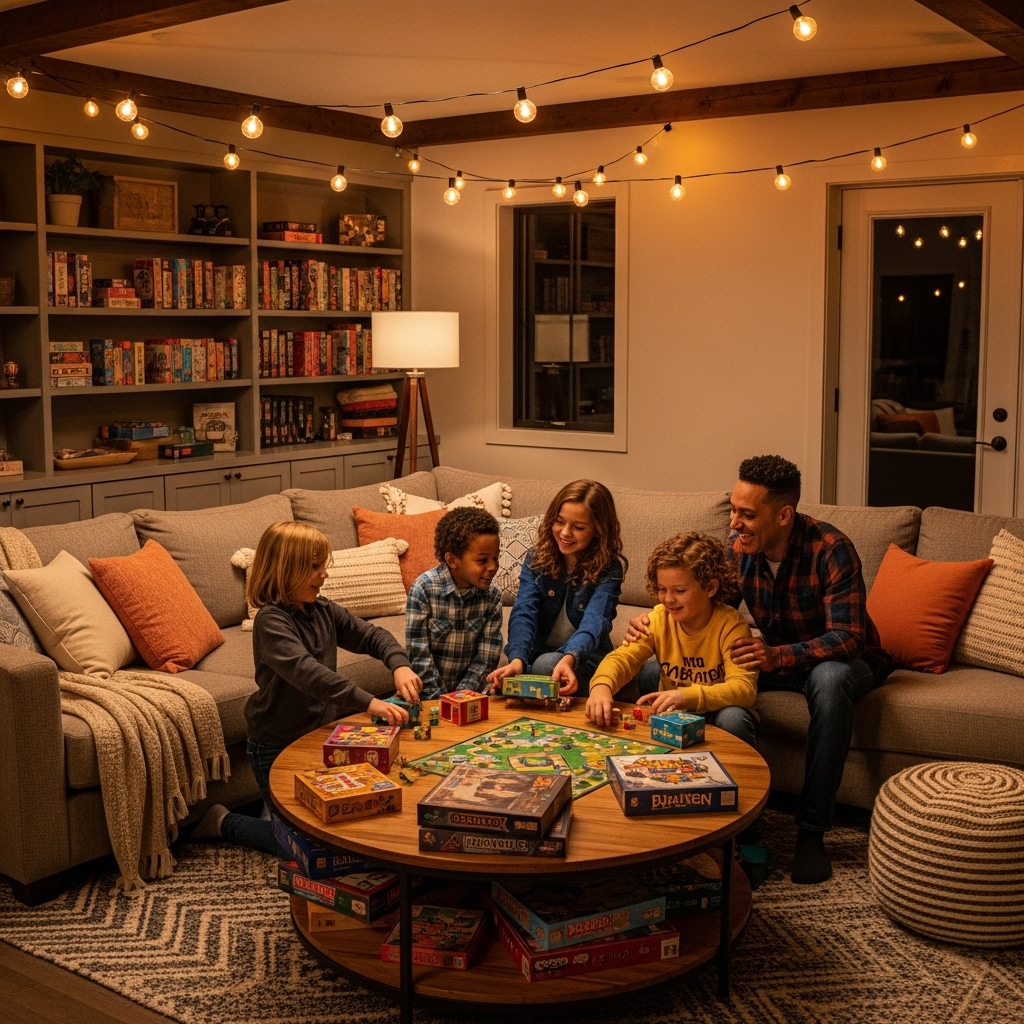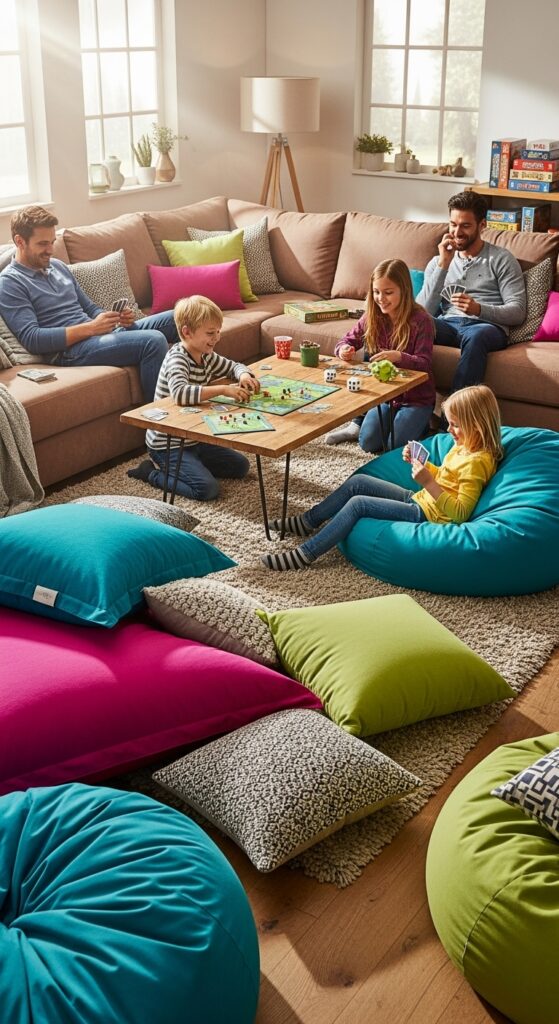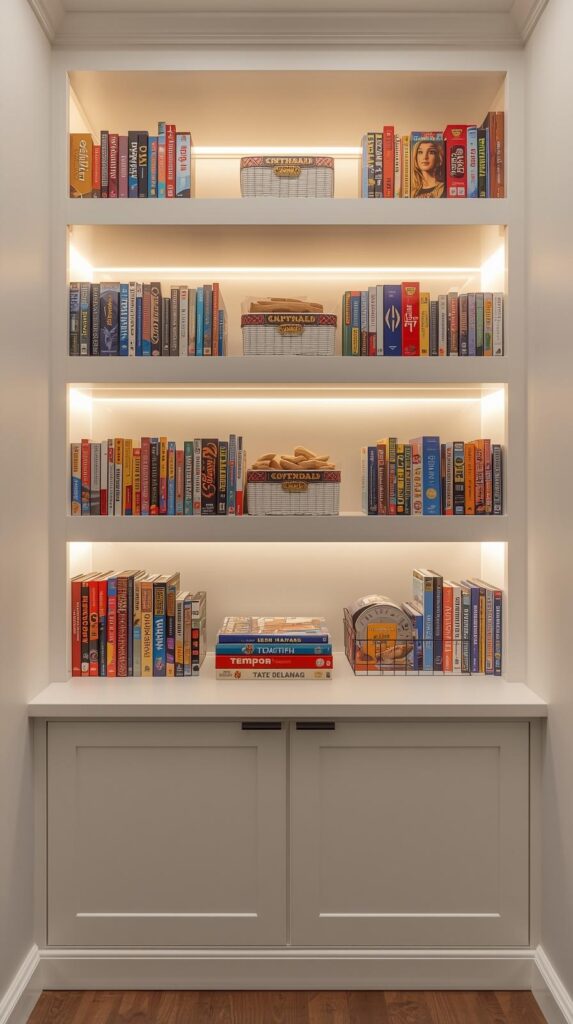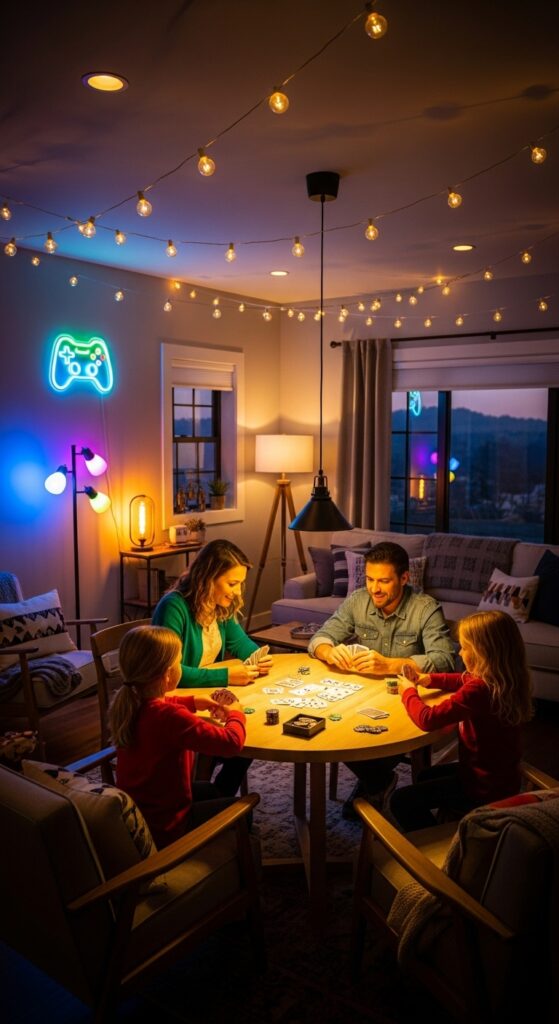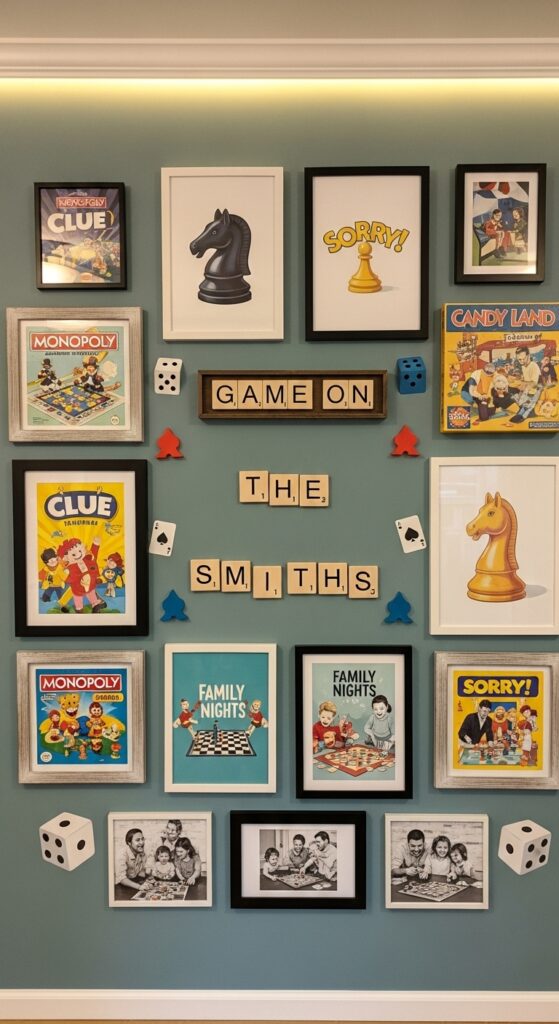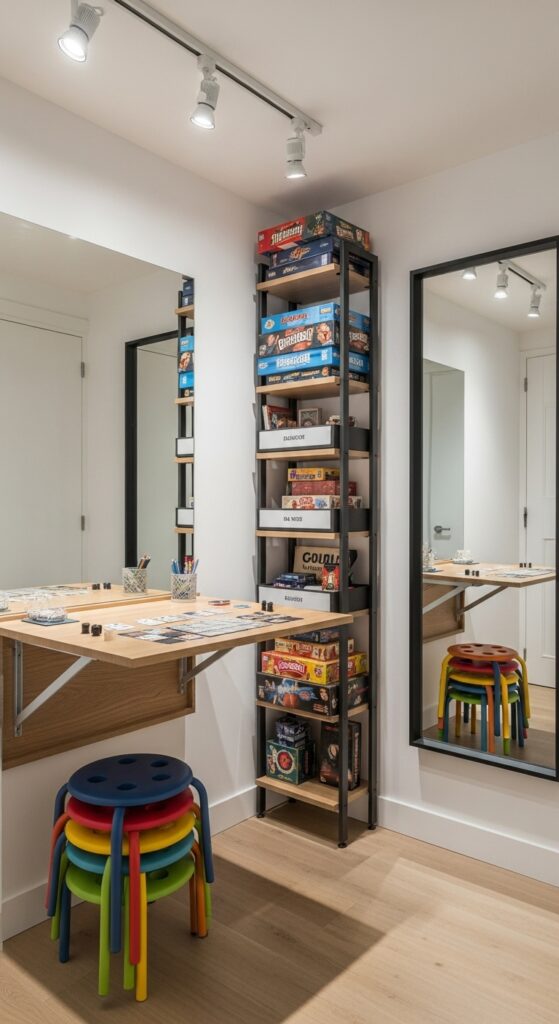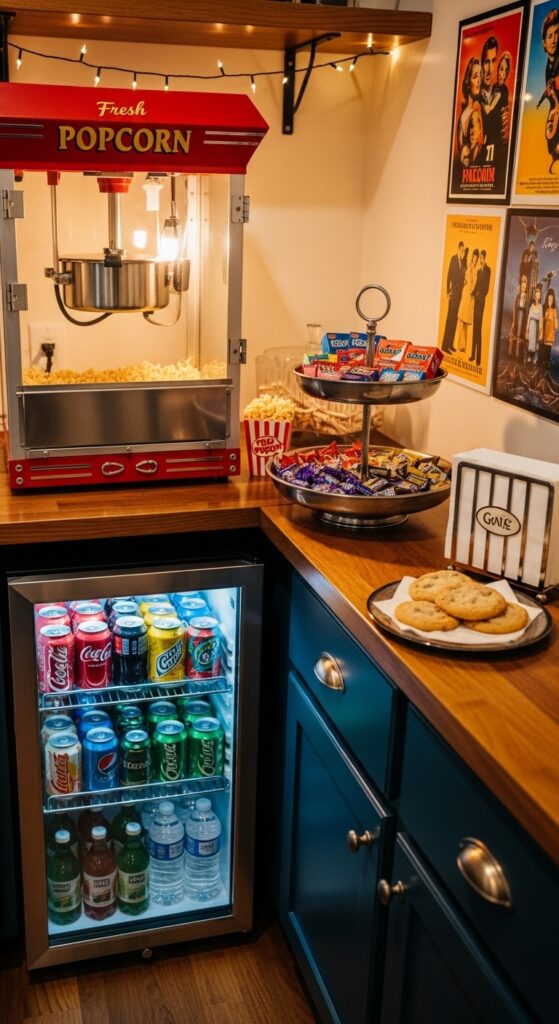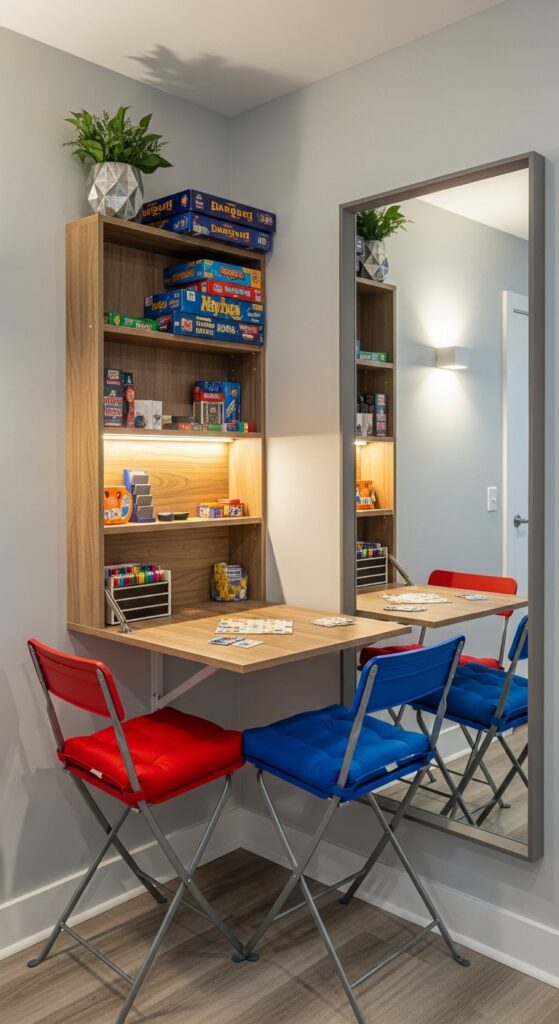Let me be honest with you—creating the perfect family game night room isn’t about having the fanciest furniture or the biggest space. It’s about setting up a zone where everyone actually wants to hang out. And trust me, after hosting countless game nights (some epic, some… not so much), I’ve figured out what really works.
Why Your Game Night Setup Actually Matters
Ever tried playing Monopoly while perched on uncomfortable dining chairs for three hours? Yeah, that’s a fast track to grumpy players and abandoned game nights. The right setup keeps everyone comfortable, engaged, and ready for one more round—even when Uncle Bob insists on his “winning strategy” for the fifth time.
Your game night space should feel like a warm hug the moment anyone walks in. It’s not just about aesthetics (though those string lights do hit different). It’s about creating an environment where your competitive cousin and your shy teenager both feel at home.
Seating That Actually Makes Sense
The Sectional Sofa Game-Changer
Here’s the thing—sectionals are the MVP of game night furniture. Why? They let people sit together without being cramped, and someone can sprawl out during longer games without taking over the whole room.
Look for sectionals with:
- Deep seats for maximum comfort during marathon Catan sessions
- Washable covers because snack spills are inevitable (looking at you, cheese dust)
- Modular pieces so you can rearrange based on your group size
I learned this the hard way after hosting a game night with seven people on a tiny loveseat. Never again. :/
Bean Bags and Floor Pillows for the Win
Don’t underestimate the power of casual seating. Bean bags are perfect for kids who can’t sit still and adults who secretly love sitting on the floor. Plus, they’re easy to move when you need extra table space.
Throw in some oversized floor pillows, and suddenly your room can accommodate twice as many people without feeling overcrowded. FYI, this setup also works great when you transition from board games to video games—flexibility is everything.
Pro tip: Get bean bags with handles. Trust me on this one.
Storage Solutions That Don’t Kill Your Vibe
Nothing ruins game night faster than spending 20 minutes searching for Uno cards. Your storage needs to be both functional and visible.
Shelving That Shows Off Your Collection
Open shelving turns your game collection into decor. Seriously! Those colorful game boxes look awesome when they’re organized properly. Plus, everyone can see what you have, which cuts down on the “what should we play?” debate.
Here’s what works:
- Cube storage units for different game sizes
- Floating shelves for displaying your prized vintage games
- Rolling carts for snacks and frequently used games
Cabinets for the Chaos
Some things need to be hidden—loose game pieces, extra controllers, that weird expansion pack you bought on impulse. Cabinets keep the clutter contained while maintaining your room’s aesthetic.
IMO, a mix of open and closed storage is the sweet spot. Show off what looks good, hide what doesn’t.
Lighting That Sets the Mood
Ever noticed how the right lighting makes everything better? Game night lighting should be bright enough to read tiny card text (looking at you, Cards Against Humanity) but warm enough to feel cozy.
String Lights Are Non-Negotiable
String lights instantly transform any room from “meh” to “let’s hang here all night.” Drape them across the ceiling, wind them around shelves, or create a canopy effect above your main gaming area.
Warm white bulbs work best—they’re inviting without being harsh. And bonus points if you get dimmable ones for movie night crossovers.
Smart Lighting for Extra Fun
RGB smart bulbs let you change the vibe with your phone. Set them to warm amber for board games, switch to energetic blue for trivia nights, or go full rainbow during hilarious fall family game night ideas that will have everyone laughing.
Quick tip: Avoid overhead fluorescent lights. They’re the enemy of good vibes.
Neon Signs Because Why Not?
A small neon sign adds personality without overwhelming your space. Game controllers, dice, playing cards—pick something that represents your family’s gaming style. It’s a conversation starter and a killer photo backdrop. 🙂
Wall Decor That Tells Your Story
Blank walls are missed opportunities. Your game room should reflect your family’s personality from the moment someone walks in.
Framed Games as Art
Got a vintage Monopoly board or a beautiful chess set? Frame it! Game boards have incredible graphic design, and framing them preserves memories while creating unique wall art.
I framed my grandmother’s old Parcheesi board, and it’s become the room’s conversation piece. Every time we play, someone asks about it.
Posters and Prints
Game-themed posters range from minimalist to maximalist. Choose what fits your style:
- Classic game advertisements for vintage vibes
- Modern graphic designs for clean aesthetics
- Pop culture gaming references for personality
Mix and match sizes for a gallery wall effect, or go big with one statement piece.
DIY Touches
Create custom wall art using Scrabble tiles to spell out family names or favorite game terms. Or display game pieces in shadow boxes for a three-dimensional effect.
These personal touches make your space uniquely yours—something generic “game room kits” can never achieve.
The Central Hub: Tables That Work
Your table choice affects everything. Too small, and you’re playing Jenga with game pieces. Too big, and you can’t reach the dice without standing up.
Round Tables for Social Gaming
Round tables keep everyone engaged. There’s no “head of the table,” so everyone feels equally involved. Plus, reaching across for cards or tiles is way easier without corners in the way.
Look for tables around 48-60 inches in diameter—big enough for most games, small enough to not dominate your room.
Multi-Use Surfaces
Consider tables that convert or fold. Game night tables can double as craft stations, homework areas, or extra dining space during holidays. Functionality is your friend when space is limited.
Some tables even have built-in game storage or reversible tops (game board on one side, regular surface on the other). Game-changer for small spaces!
The Snack Station Everyone Needs
Let’s talk about the real MVP of game night—snacks. Having a dedicated snack area keeps food away from your games (goodbye, greasy card smudges) and makes everyone feel pampered.
The Essentials
Set up a small station with:
- Mini fridge for drinks and cold snacks
- Popcorn machine because it’s fun and practical
- Tiered trays for chips, candy, and finger foods
- Napkin dispensers to minimize mess
If you have the budget, a small countertop with a sink nearby is absolute luxury. But even a rolling cart works wonders.
Keep It Stocked
IMO, the best game night rooms have a “pantry” of go-to snacks. Popcorn, pretzels, M&Ms, and juice boxes never go out of style. Having these on hand means less pre-game stress.
And here’s a weird tip: provide small bowls for each person. Sharing from one big bowl spreads germs and leads to fights over the last handful of chips. Individual portions = peace.
Small Space? No Problem
Not everyone has a dedicated game room, and that’s totally fine. You can create an amazing game night setup in a corner of your living room or even a large bedroom.
Vertical Storage Solutions
When floor space is limited, go vertical. Wall-mounted shelves, over-door organizers, and tall narrow bookcases maximize storage without eating up precious room.
Fold-down tables attach to walls and disappear when not in use. Brilliant for apartments or multi-purpose rooms.
Furniture That Transforms
Ottoman storage, nesting tables, and stackable chairs let you adapt your space instantly. Game night mode on Friday, normal living room on Saturday.
I’ve seen families transform tiny spaces into amazing game areas with smart furniture choices. It’s not about size—it’s about creativity.
Creating Zones Within Your Space
Think about traffic flow and game types. Your room should have:
- Active game zone for movement-based games (charades, Just Dance, etc.)
- Quiet game zone for strategy games requiring concentration
- Snack zone kept separate from gaming surfaces
- Storage zone for easy access without disrupting play
This zoning helps multiple activities happen simultaneously. Kids can play one game while adults tackle another, all in the same room without chaos.
Tying It All Together
Your family game night room should grow with your family. The setup that works for young kids playing Candy Land won’t fit teenagers playing Cards Against Humanity (the family edition, obviously).
Build flexibility into your design. Modular furniture, adjustable lighting, and versatile storage let you evolve the space without starting from scratch every few years.
And don’t forget—this room is about making memories. Whether you’re creating easy Halloween sensory bin ideas for toddlers or trying pumpkin decorating without knives, your game room can accommodate all your family’s activities.
Final Thoughts
Creating the perfect family game night room isn’t about following a rigid formula. It’s about understanding how your family plays, what makes everyone comfortable, and building a space that encourages connection.
Start with one or two elements—maybe great seating and better lighting—then build from there. You don’t need to do everything at once. The best game rooms evolve over time, shaped by countless game nights and shared laughs.
So grab those string lights, rearrange that furniture, and create a space where your family wants to put down their phones and pick up the dice. Trust me, you won’t regret it.
Now if you’ll excuse me, I have a Catan tournament to host. And yes, I will monopolize the brick resources. :)Retry

